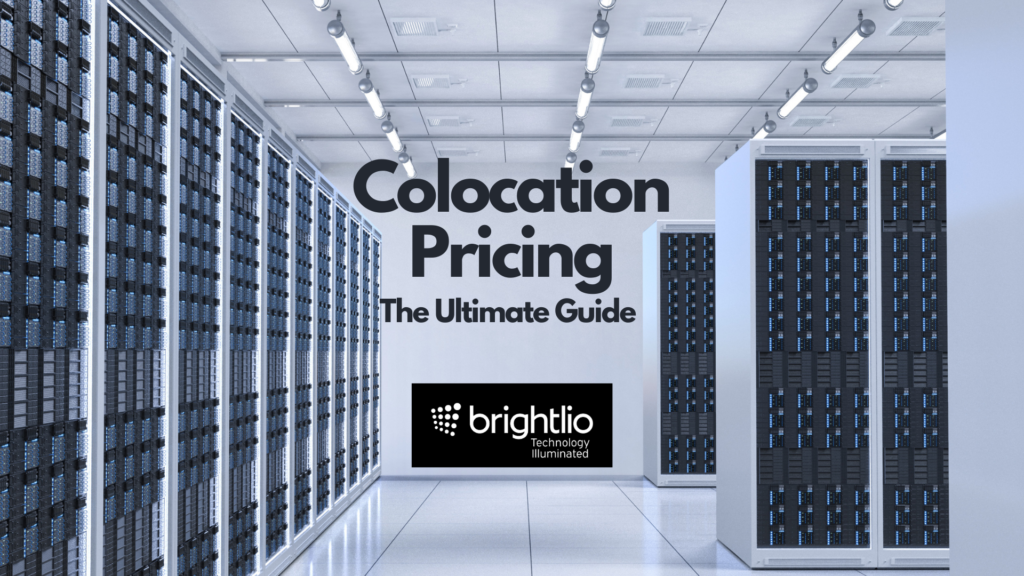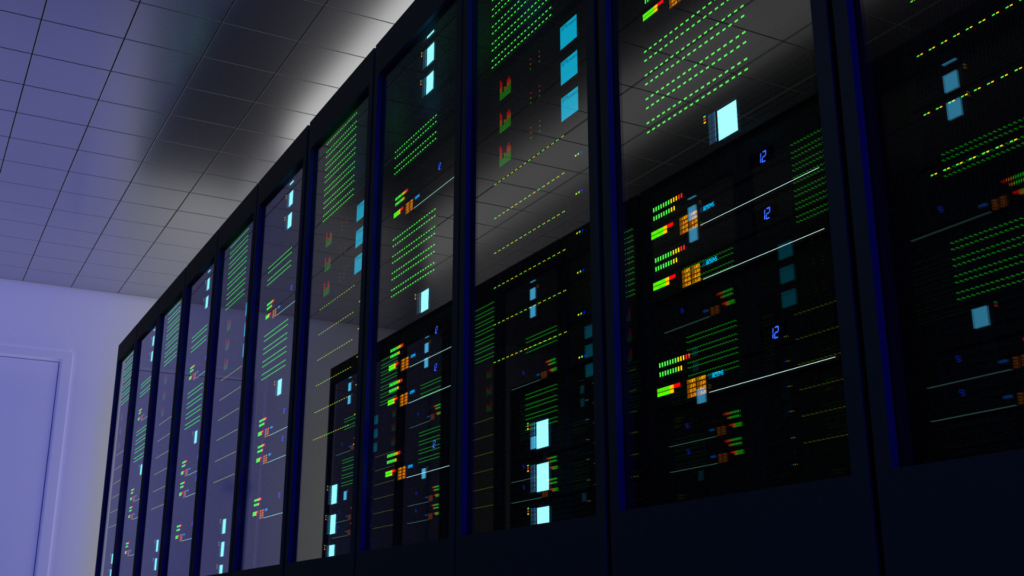
Table of Contents
Colocation Pricing: The Ultimate Guide
Looking to optimize your I.T. infrastructure without compromising on performance and reliability? Colocation could be the answer. In this in-depth guide, we’ll break down the important aspects of colocation pricing. By the end, you’ll be equipped with the insights needed to select the ideal colocation provider for your business. Get ready to make a smart, cost-effective choice that ensures your technology infrastructure is in good hands.
Short Summary
- Colocation pricing is determined by space, power, network connectivity, location, data center quality, and support services.
- Watch out for hidden fees, including overages for colocation power and bandwidth.
- When comparing quotes, it is essential to consider all variables to ensure they are apples-to-apples.
Understanding Colocation Pricing
According to CBRE, the average price for colocation services in primary North American data center markets was $163.44 per Kilowatt (kW) based on pricing of 250 kW to 500 kW opportunities. This represents an 18.6% increase year over year. If you are looking for a single rack, expect to pay higher than this range on average. Colocation prices ranged from $120 per kW in the most affordable market (Atlanta) to $250 per kW in the most expensive market (Silicon Valley). Internationally, prices range as high as $450 per kW in markets including Singapore.
This wide price range is driven by a number of factors including the cost of power, available supply, and market demand. Understanding the complex pricing models of colocation services is essential for businesses looking to optimize their data center operations. Here, we delve into the key factors that drive colocation pricing, providing an in-depth look at space requirements, power consumption, bandwidth, redundancy, and more.
How do data centers price colocation? Let’s find out.

Space
Space is a fundamental factor that drives colocation pricing. The more data center space your equipment requires, the higher the cost. Colocation facilities typically house customer servers and other hardware in cabinets or cages within their secure premises. The pricing model is based on the amount of colocation space you lease, usually measured in racks or cabinets. Larger organizations may even lease an entire private cage suite to house their data center infrastructure.
Data center services are also frequently quantified in terms of “rack units” (RU). A rack unit is a standard measurement used in telecommunications and computing to denote the vertical space available in a rack or cabinet, with equalling 1.75 inches. Thus, a standard 42U rack is 73.5 inches high and can accommodate combinations of 1U, 2U, 3U, or larger systems. When planning for a colocation deployment, it’s essential to calculate the number of rack units your server hardware and networking equipment will require. Remember to allow space for future expansion.
Data center vacancy rates are expected to be near an all-time low in 2024. Less available space and power, means higher colocation pricing overall.
Comparing Full Rack, Half Rack, and Per-Unit Options
The colocation facility will prefer to sell you a full rack (also called a cabinet). This has advantages, as you have more room to expand and can secure your equipment in a locked cabinet dedicated to your business.
Some sites offer smaller configurations, including half racks, quarter racks, or colocation per RU. These are great options for clients that need a smaller footprint, like single server colocation. It is also suitable for clients on a lower budget or those who don’t foresee the need for expansion.

Power
The power needs of your servers and IT equipment significantly influence colocation costs. Each piece of hardware in your rack consumes power. The total power consumption is usually measured in kilowatts (kW). The more power your equipment uses, the higher the monthly bill.
Power is a substantial cost for the colocation providers. This cost is passed through to their customers with a markup. For many data centers, power capacity is more limited than space. If your power requirements for your server hardware is high, you may be forced to rent space larger than you need to accommodate.
Flat Rate vs. Metered Power Usage
Colocation pricing models typically involve either a flat rate or metered power system for electricity usage. Understanding the differences between them is critical for accurately forecasting your costs.
In a flat-rate power model, you pay a fixed cost for a specific amount of power, regardless of how much you consume. This model provides predictability and simplifies budgeting, as your power costs remain the same monthly. However, if your power usage is significantly less than the allocated amount, you may pay for power you don’t use.
On the other hand, a metered power model charges you based on your actual power usage. Much like a utility bill, you pay for exactly what you consume. This model can be more cost-effective if your power usage is variable or lower than the typical allotments in a flat rate model. However, it also introduces variability in your monthly costs, making budgeting more complex if your power usage spikes unexpectedly.
In short, the choice between flat rate and metered power depends on your power usage patterns and your preference for cost predictability versus potential savings.

The Importance of Power Use Effectiveness (PUE)
Power Use Effectiveness (PUE) is a metric used to measure the energy efficiency of a data center. It is calculated by determining the ratio of the total energy used by the facility to the energy delivered to computing equipment. The PUE benchmark is utilized to calculate data center efficiency. The closer the PUE is to 1.0, the more efficient the data center is. A PUE of 1.0 is nearly impossible to achieve due to the need for cooling, power distribution, and other non-IT functions. A PUE of 1.2 or less is considered very efficient.
PUE can have a significant impact on colocation pricing. A data center with a lower PUE is more energy-efficient, using less power for cooling and other non-IT functions. This reduction in power usage can result in lower power costs, which can then be passed on to customers through lower colocation prices.
Conversely, a data center with a higher PUE is less energy-efficient, using more power for non-IT functions. This increased power usage can lead to higher power costs, which may be passed on to customers through higher colocation costs.
Bandwidth and Cross Connects
The volume and speed of data you need to transfer significantly impact the cost of colocation. Higher bandwidth means more data can be moved concurrently, which is essential for businesses running data-intensive operations or those needing high-speed, low-latency connections. Depending on the colocation provider’s pricing model, bandwidth may be billed based on the total amount used (metered billing) or the maximum speed available (unmetered billing).
Bandwidth Options and Billing Methods
Different bandwidth options and billing methods are available in colocation, including flat rate, metered power usage, 95th percentile billing, and burstable billing. The 95th percentile billing method allows a server to be billed based on the average bandwidth usage for 95% of the month, with no additional costs incurred should the server exceed the average during the remaining 5%.
Understanding the various bandwidth options and billing methods will help businesses make informed decisions when selecting a colo provider that best suits their needs. Companies can optimize their colo costs by choosing the right bandwidth option and billing method while ensuring reliable and high-performance connectivity.
Ensuring you get the internet connectivity you need is essential to the colocation solution. Each facility has different providers built-in. Ask for a list of providers to ensure the internet service provider you require is available.
Cross-Connects and Their Costs
Cross-connects (or cross connections) are a type of interconnection services that enable customers to establish dedicated, high-performance connectivity within the data center. They are typically charged on a per-port basis, with the cost varying depending on the type of connection and the data center provider.
Moreover, many colocation providers offer direct connections to major public cloud providers, such as AWS, Google Cloud, or Microsoft Azure. While these connections can provide significant benefits, they can also add to the overall cost of the service.

Redundancy and Uptime
Uptime is critical for businesses today, with many requiring nearly 100% availability. Data centers utilize redundancy in power, cooling, and network connectivity to ensure maximum uptime. However, these features can increase the overall cost. For instance, data centers offering power redundancy usually provide dual power feeds for customer equipment. If one power source fails, the second ensures continued operation, minimizing downtime risk.
According to Gartner, the average cost of IT downtime was $5,600 per minute in 2021. Given this high potential cost of downtime, businesses often find the increased price of redundant power feeds and other redundancy measures a worthwhile investment.
IP Addresses
Dedicated IP addresses, are a notable factor in colocation pricing. When you colocate, you typically need at least one IP address for your server to be reachable online. Some providers include a set number of addresses in their basic package, while others charge extra for each. The cost can vary depending on the scarcity of IPv4 addresses and the adoption of IPv6. It’s important to factor in your business’s requirements for IP addresses and how the provider prices them.
Security and Compliance
Data center security and compliance with regulatory standards are paramount for many businesses, particularly those in sectors like healthcare, finance, and government. Enhanced physical security features may include biometric access controls, key card access, CCTV surveillance, and 24/7 security personnel. Cybersecurity measures could involve firewalls, intrusion detection/prevention systems, and DDoS protection.
Adherence to compliance standards such as HIPAA for healthcare data, PCI DSS for payment card information, or ISO 27001 for information security management also drives up costs. Make sure to include your compliance requirements in your evaluation of a colocation facility.

Geographic Location
Geographic location profoundly impacts colocation pricing, primarily through power and real estate price variations. Power costs differ based on regional power generation sources, demand, and local regulations. Regions with abundant renewable energy, such as the Pacific Northwest, often have lower power costs, which reduces data center operating expenses and, consequently, colocation prices. Conversely, areas with high demand or stringent regulatory requirements, like New England or California, typically have higher power costs, leading to higher colocation prices.
Local policies can also influence power costs, with some regions offering incentives for using renewable energy or energy-efficient technologies, whereas others may levy taxes on energy use. The climate also plays a role, as data centers in cooler temperatures require less cooling, reducing overall power usage and costs.
Real estate costs also significantly impact colocation pricing. Locations with high real estate prices, such as major metropolitan areas like New York or Los Angeles, generally have higher colocation costs due to the increased expense of the data center facility itself. On the other hand, locations with lower real estate costs, like Columbus or Indianapolis, can offer more competitive colocation pricing.
Local Taxes
Local taxes can significantly impact the cost of colocation services. The tax rates vary by location and can affect several aspects of the service, particularly power consumption and equipment cost. Sales tax, for example, can add several percentage points to the overall cost in regions with high rates.
However, certain cities and states in the U.S. offer sales tax exemptions for data center equipment, leading to considerable savings. Minnesota and Virginia, for instance, provide exemptions on data center equipment and software, contributing to lower colocation costs. Quincy, in Washington State, has also become a hub for data centers, thanks to competitive power rates and similar exemptions.
It’s important to note that these exemptions usually come with certain conditions, like minimum investment levels or job creation requirements. Thus, businesses must consider these tax implications and other factors when selecting a colocation provider.
Colocating in Major Cities vs. Smaller Markets
Colocating in major cities carries certain advantages. First and foremost, large metropolitan areas often provide superior connectivity due to numerous internet exchange points. This results in lower latency and greater redundancy, which can be critical for businesses dependent on fast, reliable network connections. Also, large cities tend to have a more robust infrastructure regarding power supply and cooling facilities. Furthermore, if your business is located in or near a major city, colocating nearby could offer more convenience in terms of accessibility and proximity to IT personnel.
Brightlio’s article, “The Top Data Center Markets for 2024”, highlights markets you should consider.

However, colocation in major cities comes with certain disadvantages. The cost is likely to be higher due to elevated real estate and power prices. Large cities often face increased demand for space and power, which can drive up colocation costs. Additionally, larger cities may be more susceptible to certain types of disruptions, such as power outages, extreme weather, or even security threats.
On the other hand, smaller markets offer their unique benefits. The most notable advantage is typically cost savings. Lower real estate prices and potentially less expensive power can reduce colocation costs significantly. Also, smaller markets offer more room for expansion, which is crucial for growing businesses. These locations are also less prone to natural disasters or significant power outages, suggesting a more stable environment for data centers.
However, smaller markets may offer different connectivity, redundancy, or infrastructure robustness than larger cities. It could also mean a further distance to travel for your IT staff when physical access is required.
Contract Length
The duration of the contract also affects colocation pricing. As with many services, committing to a longer-term contract with a data center provider often results in more favorable pricing. Longer contracts provide stability for the provider and allow them to amortize their costs over a longer period.
However, long-term contracts require careful consideration. The business needs, technology landscape, and pricing models can change over time. While a three to five-year contract might offer lower monthly rates, it may lock you into services and prices that may not be competitive or relevant two years later. For instance, advancements in server technology may reduce power consumption, thus changing your power and cooling needs and potentially reducing your costs.
There is also the risk factor associated with the provider’s business stability. If the provider faces difficulties or ceases operations, a long-term contract could complicate the transition to a new provider. Therefore, it’s a careful balancing act between locking in competitive rates and maintaining the flexibility to adapt to changing circumstances.
Technical Support and Managed Services
Additional managed and professional services can significantly impact the cost. These include backup and recovery services, monitoring services, or hardware maintenance. Some providers offer these services as part of a package, while others charge an additional fee as needed.
Backup and recovery services are vital for business continuity and disaster recovery. The cost of these services can vary widely depending on the data you need to back up and the speed at which you need to recover it.
Monitoring services ensure that your servers are running efficiently and alert you to potential issues before they become significant problems. The cost of these services depends on the level of monitoring required and the complexity of your IT environment.
Remote hands services save your IT team from going onsite to manage your equipment. If something breaks or additional hardware needs to be installed, the data center technician will handle this for you. Rates vary significantly by provider.
When evaluating colocation costs, it’s essential to factor in any additional services you require to get a complete picture of the total cost of ownership.

Comparing Colocation Quotes
It can be confusing to compare quotes between providers. Here are some tips to help you pick the colocation solution that best meets your needs.
Analyzing Space, Power, and Bandwidth Costs
With colo quotes, your first stop should be analyzing the costs related to space, power, and bandwidth. Ensure the quotes provide comparable rack units, similar power allocation, and adequate bandwidth to meet your needs. Take note of the billing model – whether it’s fixed or metered. Fixed fee models provide cost predictability, while metered billing varies based on usage. Overage charges, if any, should also be carefully scrutinized.
Examining Redundancy and Data Center Tiers
Assess the redundancy built into each provider’s quote. This includes redundancy in power feeds, network connections, and cooling systems. Higher redundancy might drive costs up but will ensure better reliability.
Note the data center tier mentioned in the quotes – Tier III and Tier IV centers offer more redundancy and reliability than Tier I and II, but they also typically cost more. Some providers will also include an uptime guarantee with service credits in their Master Service Agreement.
Consider Additional Services
Go beyond the basic quote and examine the cost of additional services like remote hands, backup, recovery, cloud hosting, dedicated servers, or security services. While some providers bundle these services into their expenses, others charge separately. Also, remote hands rates can vary greatly, from as low as $75 per hour to as much as $500 per hour.
Setup fees can also vary significantly between providers. Many colo providers will be willing to waive setup fees when signing a new agreement. The recurring monthly rate is more critical to the provider than the professional services. Always try to negotiate down or eliminate install fees on standard colo deals.
Contract Length and Terms
Contract duration and its terms require careful examination. A long-term contract might reduce the monthly cost but could lock you into services with little flexibility. Look for terms that allow you to modify or terminate services early.

Factoring in Geographic Location and Associated Costs
Geographic location plays a crucial role in the cost of colocation. High real estate or power costs, and local tax implications, all factor into the overall cost of services. Ensure the quotes are from providers located in geographies that align with your needs and budget.
Assessing Data Center Quality
The quality of the data center is a crucial element to consider. This includes infrastructure quality, compliance certifications, and security measures in place. A cheaper quote might correspond to a lower-quality data center, which might cost more in the long run due to potential downtime and security risks.
Evaluating Staff Interactions
Pay attention to the importance of the data center staff. This includes the account team managing your contract and the onsite support staff. Good interactions and responsive support can significantly impact your data center experience.
Miscellaneous Factors
Several miscellaneous factors also play a role in colocation costs. These include parking costs at the data center, the ease of access to the facility, and the travel costs for your team to and from the site. These costs seem minor but can add up over time and should be factored into your total cost analysis.
Remember, the goal is to understand the total cost of ownership, not just the monthly fee. Consider all these aspects when comparing colocation quotes to make an informed decision.

Hidden Fees to Watch Out For
Businesses should be aware of several potential hidden fees to avoid unexpected charges. Among the most common are power overage charges, bandwidth overage charges, and remote hands fees.
Power overage charges can arise when your equipment uses more power than is included in your contract. Power usage in data center contracts is typically specified in kilowatts per hour (kWh), and exceeding this limit can result in substantial additional charges. Many providers charge a flat rate for a certain amount of power and then apply overage fees for consumption above that limit. Therefore, estimating your power needs and monitoring your usage closely and accurately is crucial.
Bandwidth overage charges occur when your data transfer exceeds the allocated limit in your contract. If your servers see a sudden increase in traffic or if you’re transferring large amounts of data, you could exceed your bandwidth limit and face additional costs. Understanding your data transfer needs and ensuring they are appropriately covered in your contract can help avoid these charges.
Remote hands fees represent another potential hidden cost. These are charges for tasks performed by the data center staff on your behalf, such as rebooting servers, replacing faulty components, or performing other basic maintenance tasks. While some providers include a certain number of remote hands hours in their standard package, others may charge separately for this service. Be sure to clarify this with your provider beforehand.

Summary
Understanding and comparing colocation costs can be a complex process. This colocation pricing guide is designed to help businesses navigate through this intricacy and ensure they’re making an informed decision. Considering the total cost of ownership rather than just the monthly fee is essential when evaluating colocation providers. Factors such as space, power, bandwidth, redundancy, contract length, geographical location, data center quality, staff interactions, and even seemingly minor considerations like parking and travel costs all play a role in determining the final price.
The right service provider will transparently communicate all potential charges, provide high-quality services, and offer flexible contracts that adapt to your business’s evolving needs. Remember that the cheapest quote might not always represent the best value. A holistic understanding of all factors and scrutiny of each quote is vital to finding the right colocation provider for your business needs.
We hope this guide aids your decision-making process and helps you negotiate a contract that fits your needs and budget, ultimately ensuring a successful partnership with your chosen colocation provider.
Brightlio Delivers Colocation Solutions
Brightlio, as a leading telecom broker, offers businesses the advantage of competitive data center quotes from an extensive global network of trusted providers. Our expertise in the field and our broad connections allow us to seek out the most cost-effective and reliable solutions for your specific needs. Brightlio can facilitate various options to best align with your business objectives, whether you require colocation services in major city centers or emerging markets.
Beyond colocation, Brightlio also excels in providing comprehensive technology solutions for businesses. This includes unified communications, network connectivity, public cloud solutions, and advisory services. With Brightlio, you’ll gain a partner committed to driving your success through optimized, reliable, cost-effective technology solutions.
Get started with Brightlio today!
If you liked this article, check out “A Comprehensive Guide to Cheap Colocation“.
Recent Posts
Vancouver Data Centers: Colocation in the Pacific Northwest
Business Broadband Solutions: The Ultimate Guide
Let's start
a new project together



